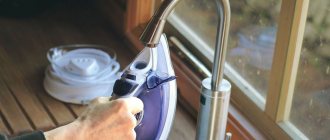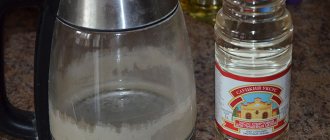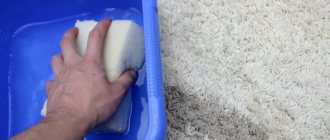Is it possible to clean an iron with vinegar?
Table vinegar is an acidic agent and can be used to clean scale and burnt marks on household appliances, in particular irons. When applied correctly, the solution eats away the deposits from the inside, after which they peel off from the sole and are easily removed with a damp sponge.
You need to carefully clean the iron with vinegar; when using the product, it is important not to use hard brushes or sponges with an abrasive surface. To prevent the acid from causing damage to the sole, it must first be diluted with water.
How often can you clean
The iron can be cleaned once every 1-2 months. All active substances are quite aggressive and can therefore harm the device. It is better to prevent scale and soot from appearing. To do this, you need to follow the rules for using the iron:
- It is best to use special iron water. Filtered liquid will do.
- It is important to observe all temperature conditions and be careful when ironing woolen, synthetic and silk items.
- After ironing, it is recommended to wipe the sole with a plain cotton cloth. You can pre-moisten it in clean water.
Today we found out how at home, using improvised means, you can get rid of dirt inside and outside the iron. Soda, vinegar, citric acid can always come to the rescue. And there is no need to spend half a day scrubbing off carbon deposits with an iron sponge. It's quite simple.
And it’s even better if these problems never happen. To do this, experts recommend that you be more careful when purchasing a device for ironing clothes. It is necessary to pay attention to the presence of a self-cleaning function. Such a unit will last much longer and will not require additional funds and time for care and cleaning.
How to dilute acetic acid
The proportions for diluting vinegar depend on its initial concentration. Both the 9% product and the 70% essence need to be diluted with water; they are not used in their pure form.
Most often, processing is carried out using ready-made table vinegar. In this case, it is enough to add 100 ml of the substance to a glass of ordinary liquid. You can also descale your iron with 70% acetic acid, but the ratio will look different. The product is taken in a volume of 100 ml, but it must be added to 1 liter of water. Thus, the proportion for cleaning will be 1:10.
The 9% solution has a fairly weak concentration and does not require strong dilution
On a note
Clean the iron outside and inside at least once every six months:
- Scale, mold - from the water tank;
- dust and dirt - from the body;
- traces of burnt fabric, rust and scale from the sole.
Cleaning your iron with vinegar is quite simple. The majority of device models will not be damaged by using the product, since it does not contain abrasive particles. It is important to keep in mind that the iron platform and the steam that is generated during heating cause severe burns. So be careful.
* Do you have your own secrets for cleaning household appliances? Share them in the comments!
How to clean the inside of an iron with vinegar
Models with a steam function show high efficiency when ironing clothes. But they have a drawback - constant contact with hard water causes the tank to become covered with scale. Lime deposits also form in channels through which hot steam passes.
You can clean the inside of the iron from scale with vinegar using the following algorithm:
- 100 ml of food acid with a concentration of 9% is diluted in a glass of water;
- the product is thoroughly stirred and poured into the device’s reservoir;
- the device is plugged in and the heat is set to maximum;
- activate the steam generation mode and wait until the solution has completely boiled away;
- pour clean water into the empty reservoir;
- heat it to a boil and release it completely using the steam button.
The method allows you to remove scale from the ironing unit tank and clean the holes in the soleplate. After the procedure, you need to remove any remaining dirty liquid from the platform with a soft sponge, and then wipe it dry.
Attention! If the iron has a self-cleaning function, then you do not need to use the steam supply. In general, the treatment is carried out in the same way, but a special button is used to remove the solution from the tank.
Preventing the appearance of scale and soot on the iron
If you regularly use vinegar to descale your iron, there will be no problems with the formation of lime deposits. Therefore, experienced housewives advise using this method regularly - at least once a month. It is worth taking into account a number of recommendations that will help avoid the appearance of scale inside the electrical appliance and on its sole:
- The water for filling a special tank must be purified: you can use boiled, settled, filtered.
- After the items are ironed, the liquid must be drained. This will prevent the water from settling inside the tank, thereby leaving lime particles in it.
- The sole of the electrical appliance must be wiped every time so that after ironing and using the steamer, not even a small amount of water or burnt lint remains on it.
- Do not unnecessarily turn the temperature regulator to the highest setting. It must match the type of laundry being ironed. Otherwise, a thin coating of burnt fibers will form on the sole of the electrical appliance. This prevents the quality of steam from escaping from the holes, which contributes to the stagnation of moisture in them.
How to clean the outside of an iron with vinegar at home
With frequent use, dark marks from adhered material appear on the soles of ironing devices. They occur especially often when the temperature regime is not observed. The sole also suffers from scale – characteristic whitish stains can be seen on the surface and in the recesses of the steam holes. There are several ways to clean an iron from burnt fabric with vinegar.
Manual cleaning
If scale and soot have appeared recently, and the layer is not very dense, you can remove the dirt manually. The cleaning algorithm looks like this:
- the iron is heated to maximum and unplugged;
- 100 ml of table acid is dissolved in 250 ml of water;
- moisten a cotton rag in the cleaning liquid and wipe the sole of the device several times in a circular motion;
- the recesses of the holes are treated separately using cotton swabs.
After the procedure, you will need to heat the iron again and iron the piece of unnecessary fabric. This will allow you to remove softened scale and carbon deposits from the platform, and at the same time remove any remaining product.
You can clean the holes from scale using a cotton swab.
Important! Even diluted vinegar has a negative effect on the skin of your hands, so you need to wear gloves when cleaning.
Cleaning compress
To clean the sole if it is heavily soiled, you can use another method. It involves long contact of the platform with an acidic agent:
- Vinegar is diluted in a glass of water in a standard proportion - 100 ml of substance per 250 ml of liquid;
- a soft natural cloth or gauze folded several times is generously moistened in the cleaning solution;
- the iron is heated properly, unplugged from the outlet and allowed to cool slightly;
- Place a hot, but not red-hot device on a wet substrate and leave it overnight.
If the vinegar solution acts on the scale for 8-10 hours, the cleaning effect will be much more noticeable. In the morning, all that remains is to rinse the sole of the device with fresh water, and then wipe it dry and dry it properly. After prolonged contact with a damp cloth, it is better not to use the iron for ironing for another 1-2 days.
Soaking soles in vinegar
The most complex and old stains can be removed with a vinegar bath. The method requires great care when applied, but gives good results. The algorithm for descaling an iron with vinegar looks like this:
- Place a flat metal pan with sides on the stove;
- lay two low wooden blocks on its bottom;
- place the iron on top of them in a horizontal position;
- pour into a container a solution prepared from 500 ml of 90% vinegar per 1 liter of water.
The level of cleaning liquid should not rise higher than halfway down the base of the iron. It is necessary to ensure that the platform of the device only goes slightly under the water.
The water and vinegar in the iron bath can be changed as needed
To clean the iron with vinegar, a homemade bath must be heated on the stove to a temperature of 80-90 °C. The unit is left to stand for 2-3 hours in the hot solution. Within half an hour after you start cleaning, the liquid at the bottom of the pan will begin to darken. This will mean that the dirt on the sole and in the recesses is gradually moving away.
After the time has passed, the iron will need to be removed from the bath for cleaning and rinsed to remove any remaining vinegar. This can be done under a tap, but it is better to pour fresh water into a flat container and immerse the sole horizontally a few millimeters into it. Finally, the unit is wiped with a clean cloth and left inoperative for a day so that it dries properly.
Methods for cleaning soles
Scale on the sole is a deposit that remains after the liquid evaporates. If it is not cleaned, things will be damaged during ironing. And the iron itself will quickly fail.
Cleaning the iron with table vinegar to remove scale is one of the most popular options. This procedure is carried out outside. It is necessary to prepare a cotton pad or cloth, cotton swabs, then you need to proceed as follows:
- Heat up the device.
- Pour vinegar into a container.
- Moisten a cotton pad and wipe the entire surface of the iron sole.
- Dip cotton swabs in vinegar and use them to treat the holes on the sole.
- Iron the cotton fabric for a couple of minutes.
This type of cleaning when the iron is on and hot should be carried out as carefully as possible, otherwise there is a risk of getting burns.
Carbon deposits are another problem with irons with any sole coating. Synthetic fabric and plastic can burn.
- You can easily clean your iron from carbon deposits at home with vinegar. This method is suitable for aluminum and Teflon coatings. All you need is a dishwashing sponge and vinegar essence. Using the rough side dipped in the product, all carbon deposits are removed. Then use a heated iron to iron the fabric, also soaked in vinegar.
- Baking soda is another great way to get rid of carbon deposits. A paste is prepared from it, which is used to wipe all areas of the sole that require cleaning. The product must be applied to a warm surface. The result is that the deposit simply “falls off”. When heating the iron further, an unpleasant odor may appear. To prevent this from happening, it is better to wipe the sole with a damp cloth.
- Are synthetic fabrics or even polyethylene burnt? Then nail polish remover will come to the rescue.
- Another effective way to remove carbon deposits is a whole tablet of hydroperite. The hot iron is thoroughly rubbed with it. The carbon deposits that have come off must be washed off with water.
Vinegar, nail polish remover and hydroperite have one big drawback - an unpleasant odor during the procedure. But these products are always available at home, and they are very cheap. Therefore, they are undoubtedly very popular. You can get rid of the unpleasant smell by ventilating the room.
But salt and paraffin, which are so advertised on many sites, do not have such a wonderful and visible effect as we would like. With their help you can remove carbon deposits, but it will take a very long time.
There is always the opportunity to use professional means. Household chemical stores sell special pencils that effectively cope with their task. The main thing is to act strictly according to the instructions. One such pencil is enough for 5-6 cleanings.
Self-cleaning function
Currently, you can find various brands and models of irons on store shelves: the most expensive ones with all sorts of functions, and the cheapest ones with a minimum of features. Before you start using the appliance, you should read the included instruction manual. Some modern iron models have a self-cleaning function. Perhaps your iron also has this capability. This function is said to clean the steam vent area well.
Of course, if a fragment of fabric is stuck to the sole of the iron or there are old burnt deposits, then the self-cleaning function will no longer help. But if you carry out the procedure after each ironing, then there will be no problems with cleaning the working surface of the electrical appliance in the future.
Aspirin and dish soap
Aspirin or acetylsalicylic acid, it turns out, is successfully used not only for medicinal purposes, but also as a means for descaling household appliances.
- Prepare a package of aspirin tablets, crush them to a powder and pour into a small container.
- Add a few drops of dishwashing detergent to the powder. You can use liquid soap instead.
- Add a little water, stir everything well.
- Pour the resulting mixture into a water container and use as in previous recipes.
If cleaning is not very successful, repeat the procedure. Finally, rinse the iron system thoroughly with water.
A mixture of citric acid, soda and vinegar
To prepare the mixture you will need citric acid, soda and vinegar.
- Prepare a small container. Pour 2 tablespoons of citric acid, 2 tablespoons of baking soda and 1 tablespoon of vinegar into it. Mix all ingredients thoroughly.
- The iron does not need to be heated before the cleaning process.
- Soak a rag generously in the product and spread it on a plastic bag.
- Place the iron, sole down, on a cloth and leave for an hour.
- After this, use a sponge to clean the softened burnt residue from the ironing surface.
- Use toothpicks or cotton swabs to clean the steam holes.
After cleaning, wash the soleplate of the iron with clean water and wipe with a dry cloth.
Benefits of baking soda
Soda does an excellent job of removing stubborn stains on the soleplate of household appliances. This is an abrasive substance that efficiently cleans any surface from dirt.
An important plus: grains of soda sand are so small that they do not pose a real threat to any type of iron sole: aluminum, steel, ceramic and even Teflon.
Other benefits of this product:
- non-toxic;
- hypoallergenic;
- universal;
- disinfects;
- cheap.
Iron cleaning chemicals
Modern models of irons are available with non-stick coatings and a self-cleaning function, which relieve the owner from constant and tedious surface care. Self-cleaning of the steamer is not provided for in all models, even from large manufacturers such as Brown, Bosch and Philips; only the newest household appliances are equipped with this function. The Teflon non-stick coating is also not perfect and a piece of fabric can burn to it. Therefore, sooner or later you will have to clean the soleplate of the iron yourself.
After a long period of use of the iron, you may notice the formation of scale; this occurs due to non-compliance with the manufacturer's recommendations specified in the instructions for the device.
Iron cleaning chemicals:
- Pencil. The simplest remedy that is sold in all hardware stores. The pencil is safe for all types of coatings and easy to use; just be careful when handling Teflon; when using, do not rub or scrape the surface. To remove burnt fabric, you need to heat the device and smear the hot surface with a pencil. When the cleaning pencil melts, all burnt particles come off; just remove them from the platform with a soft cloth and, after the iron has cooled, wash with detergent to remove any residue.
The easiest way to remove carbon deposits is to purchase a special iron cleaning pencil at a hardware store.
- Liquid products. Often these are universal preparations that can be used to clean the platform and to remove scale and internal deposits in the form of lime deposits and rust. When using, you only need to strictly follow the manufacturer's instructions.
These products can be considered the most effective, because with it you can wash even problematic stains.
If you have an expensive model of household appliance, then such large brands as Philips, Braun and Bosh produce special cleaning products for their products, which are produced in a large assortment and sold in the manufacturer’s branded stores.
Do not neglect the temperature conditions intended for certain types of fabrics.
Industrial water purification with vinegar
Naturally, the problem of water pollution with mineral salts is relevant not only at the domestic level, but also in industrial production.
At large industrial facilities, acetic acid is also used to combat scale at the water treatment stage. It is used already at the stage of mechanical cleaning; with its help, limescale deposits accumulated on the filter structures are removed.
Next, the water goes through other stages of purification and softening, this can be an iron remover or an ultraviolet filter.
Causes of scale formation in the iron
Many irons are equipped with a steaming function, which is achieved by using clean water. It is poured into a special compartment. This is where scale forms - a crystal-like deposit, the result of salt deposition. The causes of scale are as follows:
- lack of preventive cleaning of the iron;
- constant presence of liquid in the compartment;
- using tap water, not water purified from all sorts of impurities.
Advice!
To prevent scale from accumulating in the iron, you need to fill it exclusively with distilled water.
Tap water contains a huge amount of salts, so its constant presence in the iron leads to the appearance of a significant coating (white or yellowish) - scale. If it is not removed, then during the ironing process, reddish stains appear on the clothes, which have a negative effect on the fabric and spoil the appearance of the product. Hard flakes may also fall out of the compartment - limescale peeling off. When plaque reaches a critical size, the iron may stop working. The problem needs to be solved radically.
Basic rules for using and caring for an iron
- Before you start ironing, get to know your items. Read the labels on your clothes and sort them according to the permissible ironing temperature.
- Before turning on the iron, inspect the soleplate for dirt. Do not turn on the appliance if there are remains of burnt fabric on it.
- For delicate fabrics, use the lowest temperature possible. It is better to spend more time ironing than to throw away an expensive item.
- Use distilled or at least filtered water to fill the tank.
- Make sure that the iron cord is not broken or frayed, and that the socket is intact and in good working order.
- Do not iron items near flammable substances or gas cylinders.
- Before starting work, make sure that the ironing board is stable.
- Do not leave the device unattended, especially if there are small children in the house.
- It is not advisable to use an extension cord to connect the iron.
- Clean the device regularly using the products listed above.
And the last thing: do not forget to turn off the device after use. After all, this very reason can lead to at least being late for work.
Save time: selected articles delivered to your inbox every week
Prices for cleaning chemicals
In any hardware store you can choose products in a wide price range, which depends on the manufacturer. If you have an expensive model of household appliance, it is better to choose products recommended by the manufacturer.
Many brands that produce household appliances simultaneously produce chemicals for their cleaning and maintenance.
A pencil for cleaning the surface of the sole can be purchased for one hundred rubles, and a universal liquid for two hundred, but you should pay attention to the manufacturer; chemical products from global brands cannot be cheap. Therefore, if you have doubts about the quality of purchased compounds, and there is no opportunity to purchase expensive household chemicals, pay attention to home remedies that will take more time to clean, but are more gentle on the household appliance.
Do not use metal sponges or hard brushes to clean the soleplate of the iron, especially if it has a Teflon or ceramic coating.
With proper preventive measures and proper operation, your iron will stop causing trouble and will only delight your hostess and the whole family with ironed clothes and linen.
If you approach this process wisely and follow all the rules, then the iron will last for decades.
Basic cleaning rules
Basic rules for an effective procedure:
- during the cleaning process, it is strictly not recommended to use hard metal brushes and sponges, so as not to damage the surface of the electrical device;
- neither vinegar nor its solution should be poured into the iron or allowed to touch the plastic parts of the device;
- The procedure should be started as soon as contamination has been detected. Otherwise, the iron will begin to overheat inside, iron less effectively, and litter the laundry with dirt, leaving ugly stains.
Advice: Miss Clean magazine recommends using only filtered, boiled or special water to refill the iron, and be sure to drain the remaining liquid after ironing. So the plaque will accumulate very slowly, for at least 6 months.











